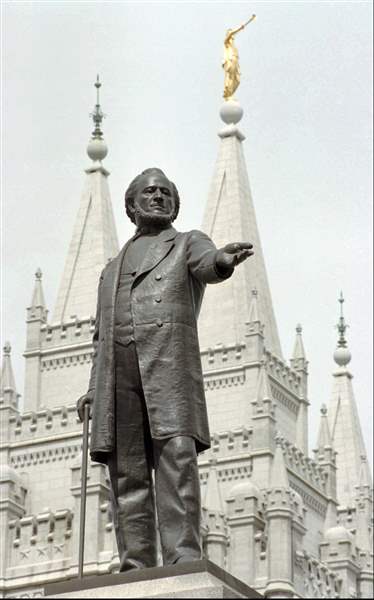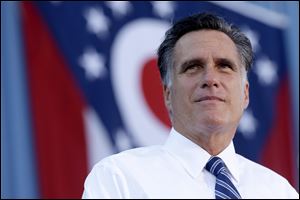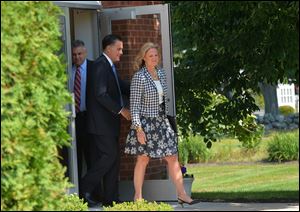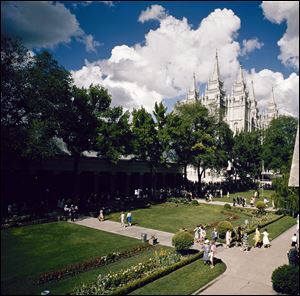
Would Mormonism shape Romney policy?
Family is foundation of candidate's church
11/4/2012
Mitt Romney can trace ancestors back to associates of Brigham Young, subject of a statue at the temple in Salt Lake City.
ASSOCIATED PRESS

Republican presidential candidate Mitt Romney, seen here last month in Worthington, Ohio.

Mitt Romney can trace ancestors back to associates of Brigham Young, subject of a statue at the temple in Salt Lake City.
If Mitt Romney is elected president Tuesday, it will be the first time a Mormon — a member of the Church of Jesus Christ of Latter-day Saints — will inhabit the White House.
And Mr. Romney is not just a member of the Mormon church, he is a leader.
When he started Bain Capital in 1984, he was the bishop of his ward, or congregation, and then was made a president of his Boston stake, or region of wards of the Church of Jesus Christ, the church’s preferred shorter name.
How would his Mormon faith affect his presidency, if elected, in policy and in practices?
“I look at someone like Mitt Romney and understand the faith and the background he comes from,” said Chris Miller, who is the bishop, or the unpaid head, of the Perrysburg ward. “To me, it represents a lot of personal integrity, character, and commitment to whatever he applies himself. He cares about people and all those he’s in contact with. As president of the United States, the White House is going to care deeply for every individual citizen. It’s almost like a family.”
While many faiths focus on the individual’s life, for the Church of Jesus Christ, the family is the fundamental unit of the church. That differs from many religions, which focus primarily on the individual and on personal salvation.
Calls by The Blade to the Romney campaign seeking to discuss Mr. Romney’s faith and how it would affect his presidency, if elected, were not returned.
That leaves as an open question whether the practices of the Latter-day Saints are so strongly held by Mr. Romney that he might follow them and try to change U.S. law.
The church disapproves of coffee. Just as New York City Mayor Michael Bloomberg instituted restrictions on soda, could Mr. Romney take our coffee?
Mr. Miller, head of the Perrysburg Latter-day Saints, said that won’t happen. “As members of the church, one of the main principles that we believe in is that we are all given the gift of what we call free agency. We have the ability to make decisions for ourselves. Mitt, if he were president, he has the belief that he follows but that’s not meant that he’ll dictate that to everyone in the world. Those are his standards and his mandates. He doesn’t drink coffee. That doesn’t mean that’s a mandate for everyone” to give up coffee.
And how might Mr. Romney use the law for his ends? Think of his not joining the military during the Vietnam War era. The Web site Snopes.com wrote that Mr. Romney received four draft deferments between 1965 and 1970: three student deferments and one as a “minister of religion” while he was a Mormon missionary in France.

Republican presidential candidate Mitt Romney and his wife Ann leave the Church of Jesus Christ of Latter-Day Saints in Wolfeboro, New Hampshire.
Mormon males enter the faith’s priesthood at age 12, and all men are priests at different levels of succession.
Women don’t serve in the church’s ordained ministry but have more nurturing and care-giving roles, including in the Relief Society, serving people in need, which Mr. Miller maintained is the oldest women’s organization in the country.
Mormon missionaries perform religious ministry in their assignments, and the minister deferment was considered valid — using the law, not bending it — for Mormons doing missionary work.
Are the differences of Latter-day Saints from the more traditional faiths significant? When religious stories are told, or holy figures are referred to, Christians hear the familiar names of, say, Adam, Noah, and Isaac. But, it’s fair to add, many names in the Hebrew Bible are unfamiliar to many people who consider themselves devout followers of Judaism, Christianity, or Islam.
Latter-day Saints hear the familiar Old Testament names, but they also hear names that would not be familiar to others. “We are blessed to be led by living prophets — inspired men called to speak for the Lord, just as Moses, Isaiah, Peter, Paul, Nephi, Mormon, and other prophets of the Scriptures,” Latter-day Saints doctrine states.
Another faith difference is seen in a person’s appearance. Mormons are encouraged to dress up to go to church and to dress modestly in their everyday lives. Some individuals wear special garments under their clothes to remind them of their faith, and those who are admitted to temples will dress in white clothing.
Some photographs of Mr. Romney reveal the outline of an undershirt — one of the sacred temple garments — beneath his dress shirt. Special clothing is not unique to the Church of Jesus Christ; the tassels on the corners of garments some Jewish men wear can be seen beneath their shirts, and, of course, the hijab or veil of Muslim women is outer religious wear.
When a Latter-day Saint certifies his or her worthiness to enter the temple, which is open only to those recommended by priesthood leaders, and is endowed with sacred gifts, one item presented is the temple garment commonly known as Mormon underwear.That underclothing “provides a constant reminder of the covenants ... made in the temple,” a church book states.
“You should not expose it to the view of those who do not understand its significance,” the instruction book continues. “When you wear it properly, it provides protection against temptation and evil.”
Faith differences between Latter-day Saints and those of different beliefs come up, but they also guide the flock.
“The first thing that people need to understand is that we are devout followers of Jesus Christ,” Mr. Miller said. “We believe that he is our Savior, our Redeemer. We follow his teachings and commandments. We have the Book of Mormon as additional testimony of Jesus Christ as our Savior and Redeemer. I think one of the big things about members of the church is that we really live our faith. It’s very personal to us and we practice it every day. It’s not something we visit occasionally.”
A foundation of the church is family orientation. The church encourages a weekly evening when just the family is together without distractions.
There is a family atmosphere within a ward because of the practice of home teachers caring for one another’s spiritual, and sometimes other, needs outside the church.
Home teachers have their own home teachers — even bishops do. And then there is the perception of celestial families, where baptizing ancestors assures them a place in heaven. The family trees of Mormons get special tending.

Romney family tree
Mr. Romney can trace his lineage to the founding of this truly American religious denomination — now a worldwide religion — back to ancestors who worked and worshiped alongside Joseph Smith, Jr. (1805-44), the founder and first president of the Church of Jesus Christ of Latter-day Saints, and to Brigham Young (1801-77).
After Mr. Smith was killed, Brigham Young moved the church to Salt Lake City, where he and Mr. Romney’s forefathers worked to make Utah a Mormon land.
The families from which Mr. Romney descended don’t always have smooth lines from one generation to the next. Born in 1947, he can paint a straightforward picture as head of his family with his wife, Ann, born in 1949. Together they have five children and 18 grandchildren.
But go back in time past his parents, former Michigan Gov. George Wilcken Romney (1907-95) and Lenora LaFount Romney (1908-98) and their seven children, and some guessing is necessary. A major complicating factor is marriage, or more specifically plural marriage.
Some of Mr. Romney’s great-great-grandparents and great-grandparents took part in a practice of Mr. Smith, Mr. Young, and other early Mormons that still at times overshadows the faith, a practice that was officially ended by the church in 1890 — polygamy, or plural marriage.
“It gets a little bit into some doctrinal areas, but as members of the church it’s our belief that the president of the church is a prophet of God,” Mr. Miller, head of the Perrysburg congregation, told The Blade. “He receives revelations from God. [Regarding plural marriage], there was direction from God that that was something that was needed at that time, but that was eliminated over 100 years ago through revelation.
“The prophet at that time eliminated plural marriage. That was not a part of the church, and no one in the church practices that and has not for well over 100 years,” Mr. Miller said.
Mr. Romney’s forefathers helped to build the Church of Jesus Christ.
They advised Mr. Smith and Mr. Young as church apostles. They took Mormonism to Mexico when the United States would not accept the polygamy of early Latter-day Saints years, from 1852 to 1890.
While there have been reports that Mr. Romney is a blood descendant of Joseph Smith, evidence for that is not strong.
Mr. Smith did not practice open polygamy — the church went public about multiple marriage after Mr. Smith’s death — but he is said to have had more than one wife, to have married three sets of sisters, even, and to have had at least 11 children.
Brigham Young had 27 wives and 56 children. With those numbers, genealogical research can produce “six degrees of separation”-type ties between people and between early church families.
The Church of Jesus Christ of Latter-day Saints might possess the world’s largest collection of genealogical resources, but it also respects family privacy. The church referred all questions from The Blade related to Romney genealogy to the Romney family and campaign.
Multiple marriage
Polygamy remains a very strong topic of discussion more than a century after the hierarchy of the Latter-day Saints banned the practice.
Polygamy was public for the church and became a political and religious issue, affecting when Utah would join the United States, in 1896.
Mr. Romney’s great-great-grandfather Parley Parker Pratt (1807-57) had 12 wives and 31 children; great-grandfather Helaman Pratt (1846-1909) had five wives and four children.
For many people, it seems rare to trace family trees with simple arithmetic; complex geometry is called for because of remarriages, affairs producing children, and even, as in Mr. Romney’s ancestry, church-sanctioned polygamy.
Half siblings, cousins once removed, and stepparents seem simple compared to tracing the paths of Mr. Romney’s great-grandfather Miles Park Romney’s five wives and 27 children.
The Pratts and the Romneys came together with the marriage of Anna Amelia Pratt (1876-1926) and Gaskell Romney (1871-1955), Mitt Romney’s paternal grandparents. Gaskell Romney was one of Hannah Hood Hill Romney (1842-1929) and Miles Park Romney’s (1843-1904) 10 children.
Anna Amelia Pratt Romney’s parents were Helaman Pratt and Anna “Dora” Wilcken Pratt (1854-1929). Helaman Pratt was one of four children of Parley Parker Pratt and Mary Wood Pratt (1818-98). “Dora” was one of eight children of Eliza Reiche Wilcken (1830-1906), who was one of Charles Wilcken’s (1831-1914) six wives; Mr. Wilcken had four other children.
Michael Kranish and Michael Paulson included Romney family history in a Boston Globe feature in 2007, including that one of Mitt Romney’s great-great-grandfathers, Miles Archibald Romney (1808-77), converted to the church in 1837 when he lived in Dalton-in-Furness, England.
Miles Archibald Romney and Parley Parker Pratt were first-generation Mormons helping to build the faith. The church was officially founded in 1830 in New York state, and in 1837, it was already sending missionaries to other countries. When Miles Romney and his wife, Elisabeth Gaskell Romney (1809-84), moved to America in 1841 from England, one companion on the ship was Brigham Young, who was in England as a Mormon missionary.
Parley Parker Pratt was an original member of Joseph Smith’s Quorum of the Twelve Apostles, the body of “prophets, seers, and revelators,” according to the church, that, along with the church president and two counselors and “under the direction of Jesus Christ,” leads the church. Mr. Pratt was killed in 1857 in Van Buren, Ark., by the former husband of one of his wives. Mr. Pratt’s brother Orson (1811-81) was also one of the 12.

The temple in Salt Lake City, Utah, is the spiritual headquarters of the Mormon faith. Only those recommended by priesthood leaders may enter.
Mormon lessons
As a young member of the Church of Jesus Christ, Mitt Romney learned the beliefs that were “revealed” by Joseph Smith, Jr. in the 1800s.
Latter-day Saints believe that when Mr. Smith was 14 and living in Palmyra, N.Y., he was visited by God and Jesus and was instructed not to join any existing church.
Three years later, according to the Church of Jesus Christ, it came to pass that an angel named Moroni told Mr. Smith about buried golden plates on which was written the Book of Mormon.
Mr. Smith said he received annual visits from Moroni until age 18, when Moroni told him where to find the plates — a stack 6 inches high and 8 inches square — and two special stones to be used to translate the language on them into English.
Mr. Smith is said to have used the stones to dictate the Book of Mormon to his scribe, Oliver Cowdery.
Included among those beliefs are that the church is Christian, but that Mr. Smith’s discovery was divine direction to restore the church of Jesus because they say Christianity departed from Jesus’ teachings.
Mormons say that original teachings of Christianity were lost or adapted since Jesus’ time, and the Latter-day Saints’ religion is based on Jesus’ original teachings.
Also, while mainline Christians believe their “Holy Trinity” of father God, son Jesus, and the Holy Spirit are one heavenly being, Latter-day Saints believe the three are individuals, not one entity.
Articles of faith
When a newspaper editor asked Mr. Smith about his religion in 1842, Mr. Smith wrote 13 points, which have come to be known as the Latter-day Saints’ articles of faith. Among the beliefs Mr. Smith stated are:
“We believe that the first principles and ordinances of the Gospel are: first, Faith in the Lord Jesus Christ; second, Repentance; third, Baptism by immersion for the remission of sins; fourth, Laying on of hands for the gift of the Holy Ghost.”
Mr. Smith included the book he uncovered: “We believe the Bible to be the word of God as far as it is translated correctly; we also believe the Book of Mormon to be the word of God.”
Mr. Smith wrote of the future and a particular place: “We believe in the literal gathering of Israel and in the restoration of the Ten Tribes; that Zion [the New Jerusalem] will be built upon the American continent; that Christ will reign personally upon the earth; and, that the earth will be renewed and receive its paradisiacal glory.”
There is also a point of openness to others, kind of a live-and-let-live advocacy: “We claim the privilege of worshiping Almighty God according to the dictates of our own conscience, and allow all men the same privilege, let them worship how, where, or what they may.”
In other words, though Mr. Smith’s church is strong in missionaries converting people to its faith, he recognized that people will continue to have different beliefs and not all be one church.
Mr. Miller, head of the Mormons in Perrysburg, said that by Mitt Romney’s religious work and other actions, he demonstrates the present faith of the Latter-day Saints as formed in part by earlier generations of his family, even if he talks about it very little in his campaign.
“You can only imagine the excitement of members in the church with someone as close to the White House as Mitt Romney is,” Mr. Miller told The Blade.
“I just hope, if he is elected, that he’s a great leader. Everything that he’s been involved in shows what a great leader he is.”
Contact TK Barger at: tbarger@theblade.com or 419-724-6278.